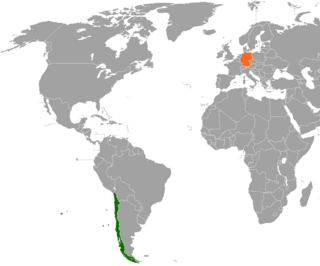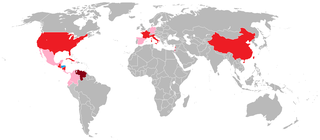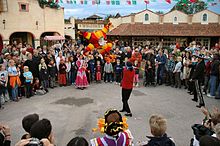
Mexicans are the citizens and nationals of the United Mexican States.The most spoken language by Mexicans is Spanish, but many also speak languages from 68 different Indigenous linguistic groups and other languages brought to Mexico by recent immigration or learned by Mexican expatriates residing in other countries. In 2015, 21.5% of Mexico's population self-identified as having indigenous ancestry, however this also included partially indigenous Mexicans. In 2020, the number was estimated at 11.8 million There are currently about 12 million Mexican nationals residing outside Mexico, with about 11.7 million living in the United States. The larger Mexican diaspora can also include individuals that trace ancestry to Mexico and self-identify as Mexican but are not necessarily Mexican by citizenship. The United States has the largest Mexican population in the world after Mexico at 37,186,361 in 2019.

German Mexicans are Mexican citizens of German origin. Most documented ethnic Germans arrived in Mexico during the mid-to-late 19th century and were spurred by government policies of Porfirio Díaz. Many of them took advantage of the liberal policies in Mexico at the time and went into merchant, industrial, and educational ventures. However, others arrived without any or much capital as employees or farmers. Most settled in Mexico City and the surrounding states of Puebla and Veracruz as well as the northern states of Sonora, Sinaloa, Jalisco, and Chihuahua. Later settlers headed south towards the Yucatán Peninsula. Significant numbers of German immigrants also arrived during and after both World Wars. The historic strength of German-Mexican relations has contributed to Mexico having the fourth largest German population in all Latin America behind Brazil, Argentina and Chile.

Immigration to Mexico has been important in shaping the country's demographics. Since the early 16th century, with the arrival of the Spanish, Mexico has received immigrants from Europe, Africa, the Americas, and Asia. Today, millions of their descendants still live in Mexico and can be found working in different professions and industries.
Turks in the Netherlands refers to people of full or partial Turkish ethnicity living in the Netherlands. They form the largest ethnic minority group in the country; thus, the Turks are the second-largest ethnic group in the Netherlands after the ethnic Dutch. The majority of Dutch Turks descend from the Republic of Turkey; however, there has also been significant Turkish migration waves from other post-Ottoman countries including ethnic Turkish communities which have come to the Netherlands from the Balkans, the island of Cyprus, as well as from other parts of the Levant. More recently, during the European migrant crisis significant waves of Turkish minorities from Syria and Kosovo have also arrived in the Netherlands. In addition, there has been migration to the Netherlands from the Turkish diaspora; many Turkish-Belgians and Turkish-Germans have arrived in the country as Belgian and German citizens.

American Mexicans are Mexicans of full or partial Americans heritage, who are either born in, or descended from migrants from the United States and its territories.
Emigration from Colombia is a migratory phenomenon that started in the early 20th century.
Atlanta, the largest urban center in the southeastern U.S., has undergone profound social, cultural and demographic change since the 1980s. Prior to that time, the region contained two main ethnic groups: European Americans and African Americans. However, from 1980 to 1995, the Hispanic population of Georgia grew 130%. By 1996 there were 462,973 Hispanics in Georgia. From 1990 to 2000, Georgia became the third largest state for migrating Hispanics and Latinos.

Emigration from Mexico is the movement of people from Mexico to other countries. The top destination by far is the United States, by a factor of over 150 to 1 compared to the second most popular destination, Canada.
Mexican immigration to Spain refers to the Mexican population in Spain and their Spanish-born descendants. The Mexicans living in Spain are composed primarily of students, skilled professionals, spouses of Spaniards, as well as Mexican citizens who also have Spanish nationality. In December 2008, the National Statistics Institute in Spain had 14,399 registered Mexicans within its territory, of which 7,210 hold other nationalities of the European Union or are family members of EU citizens. To this number must be added those with dual nationality, who are not in Spanish records as foreigners. Mexican and Spanish laws allow dual citizenship, and many Mexicans who have asked for it, whether they are residents in Spain as grandchildren or they are children of Spanish migrants to Mexico. In 2010, the Ministry of Foreign Affairs of Mexico recorded 21,107 Mexicans living in Spain, who became the third largest Mexican community residing abroad, after the United States and Canada; and the largest Mexican community in Europe.
Transmigrant is a term, greatly developed by the work of Nina Glick Schiller, which is used to describe mobile subjects that create and sustain multiple social relations that link together their societies of origin and residence. These mobile subjects are now viewed as transnational migrants or transmigrants to distinguish them from migrants and immigrants.

The nations of Germany and Mexico first established formal diplomatic relations in 1879, following the unification of Germany. In 1917, the German Empire proposed a World War I alliance with Mexico against the United States in the Zimmermann Telegram before it was foiled by British intelligence agents. The two nations were twice on the opposite sides of 20th century conflicts: first in the Spanish Civil War from 1936 to 1939, and later during World War II from 1942 to 1945. Mexico established relations with both halves of partitioned Germany in 1952 and maintained the relationship through the German reunification in 1990.
Mexican immigration to Costa Rica comprises people who emigrated from Mexico to Costa Rica and their descendants. Costa Rica has the most Mexicans living in Central America, aside from Guatemala. The waves of migration from Mexico to Costa Rica started from 1970s, as they were attracted by a stable democracy, a mild climate and political stability that characterizes this country south of Central. The Mexican population in Costa Rica reaches more than 5,000 people who exercise as professionals, doctors, secretaries, among other services. Costa Rica is the seventh destination for Mexican immigrants in the world, and first in Hispanic America. Unlike other destinations, most Mexicans who immigrate to Costa Rica are mainly from Nuevo León, Tamaulipas, Chihuahua, Baja California and Mexico City. Despite having more cultural elements similar to the northern countries of Central America, such as Guatemala, Mexicans in Costa Rica are quickly assimilated by the Costa Rican population. From 2010, a new wave of Mexican immigrants began coming to Costa Rica, and these are mainly young professionals, who find no opportunities in their country, migrate to the Central American country. Many others are running away from the waves of violence following the war against drug trafficking in Mexico.

There is a small Chilean diaspora in Mexico. According to the 2010 census, there were 5267 registered Chilean citizens living in Mexico, an increase from the 3,848 registered in the 2000 census. Chilean immigrants constitute the fifth largest community of South Americans in Mexico and the fifteenth largest immigrant community overall.

German-Chilean relations are foreign relations between Germany and Chile. Around 12,300 kilometers separate Chile and Germany but both nations still share a wide range of bilateral relations. Over the course of the last 150 years many Germans have settled in Chile for several different reasons. Migrating in the opposite direction, several thousand Chileans sought refuge in Germany during Pinochet's dictatorship.
Mexican immigration to Cuba comprises people who emigrated from Mexico to Cuba and their descendants. Cuba is home to the most Mexicans living in the Caribbean. The waves of migration from Mexico to Cuba started from the 1970s, attracted by a mild climate.
Immigration in Guatemala constitutes less than 1%, approximately 140,000 people, and most come from neighboring countries. Guatemala's historic ethnic composition is mostly immigrant stock from Europe and as well as Asian and Africans brought during the era of slavery. Currently, the composition of Guatemala consists mostly of mestizos, Amerindians and Europeans, and to a lesser extent, Garifuna. In recent decades, immigration to Guatemala has led to an increase in desire for more businesses and tourist attractions, after there had been a considerable drop from 1950 to 1980.
At the 2011 census, the number of immigrants in Costa Rica totaled about 390,000 individuals, or about 9% of the country's population. Following a considerable drop from 1950 through 1980, immigration to Costa Rica has increased in recent decades.
The Latin American diaspora refers to the dispersion of Latin Americans out of their homelands in Latin America and the communities subsequently established by them across the world.

The COVID-19 pandemic in Mexico is part of the ongoing worldwide pandemic of coronavirus disease 2019 caused by severe acute respiratory syndrome coronavirus 2.

Immigration to the Republic of Honduras is a complex demographic phenomenon that has been an important source of population growth and cultural change through the centuries throughout much of Honduran history. In the ten months to October 2022, about 120,000 migrants passed through Honduras, most of them being irregular.












